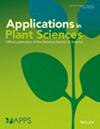A pipeline for the rapid collection of color data from photographs
IF 2.4
3区 生物学
Q2 PLANT SCIENCES
引用次数: 2
Abstract
Abstract Premise There are relatively few studies of flower color at landscape scales that can address the relative importance of competing mechanisms (e.g., biotic: pollinators; abiotic: ultraviolet radiation, drought stress) at landscape scales. Methods We developed an R shiny pipeline to sample color from images that were automatically downloaded using query results from a search using iNaturalist or the Global Biodiversity Information Facility (GBIF). The pipeline was used to sample ca. 4800 North American wallflower (Erysimum, Brassicaceae) images from iNaturalist. We tested whether flower color was distributed non‐randomly across the landscape and whether spatial patterns were correlated with climate. We also used images including ColorCheckers to compare analyses of raw images to color‐calibrated images. Results Flower color was strongly non‐randomly distributed spatially, but did not correlate strongly with climate, with most of the variation explained instead by spatial autocorrelation. However, finer‐scale patterns including local correlations between elevation and color were observed. Analyses using color‐calibrated and raw images revealed similar results. Discussion This pipeline provides users the ability to rapidly capture color data from iNaturalist images and can be a useful tool in detecting spatial or temporal changes in color using citizen science data.

用于从照片中快速收集颜色数据的管道。
前提:在景观尺度上对花朵颜色的研究相对较少,可以解决景观尺度上竞争机制(例如,生物:传粉者;非生物:紫外线辐射、干旱胁迫)的相对重要性。方法:我们开发了一个R闪亮管道,从使用iNaturalist或全球生物多样性信息设施(GBIF)搜索的查询结果自动下载的图像中采样颜色。该管道用于对iNaturalist的约4800张北美壁花(Erysimum,Brassicaceae)图像进行采样。我们测试了花朵的颜色是否在整个景观中非随机分布,以及空间模式是否与气候相关。我们还使用包括ColorCheckers在内的图像将原始图像的分析与颜色校准图像进行比较。结果:花的颜色在空间上具有强烈的非随机分布,但与气候的相关性不强,大部分变化由空间自相关解释。然而,观察到了更精细的尺度模式,包括海拔和颜色之间的局部相关性。使用颜色校准和原始图像的分析显示了类似的结果。讨论:该管道为用户提供了从iNaturalist图像中快速捕捉颜色数据的能力,并且可以成为使用公民科学数据检测颜色的空间或时间变化的有用工具。
本文章由计算机程序翻译,如有差异,请以英文原文为准。
求助全文
约1分钟内获得全文
求助全文
来源期刊

Applications in Plant Sciences
PLANT SCIENCES-
CiteScore
7.30
自引率
0.00%
发文量
50
审稿时长
12 weeks
期刊介绍:
Applications in Plant Sciences (APPS) is a monthly, peer-reviewed, open access journal promoting the rapid dissemination of newly developed, innovative tools and protocols in all areas of the plant sciences, including genetics, structure, function, development, evolution, systematics, and ecology. Given the rapid progress today in technology and its application in the plant sciences, the goal of APPS is to foster communication within the plant science community to advance scientific research. APPS is a publication of the Botanical Society of America, originating in 2009 as the American Journal of Botany''s online-only section, AJB Primer Notes & Protocols in the Plant Sciences.
APPS publishes the following types of articles: (1) Protocol Notes describe new methods and technological advancements; (2) Genomic Resources Articles characterize the development and demonstrate the usefulness of newly developed genomic resources, including transcriptomes; (3) Software Notes detail new software applications; (4) Application Articles illustrate the application of a new protocol, method, or software application within the context of a larger study; (5) Review Articles evaluate available techniques, methods, or protocols; (6) Primer Notes report novel genetic markers with evidence of wide applicability.
 求助内容:
求助内容: 应助结果提醒方式:
应助结果提醒方式:


